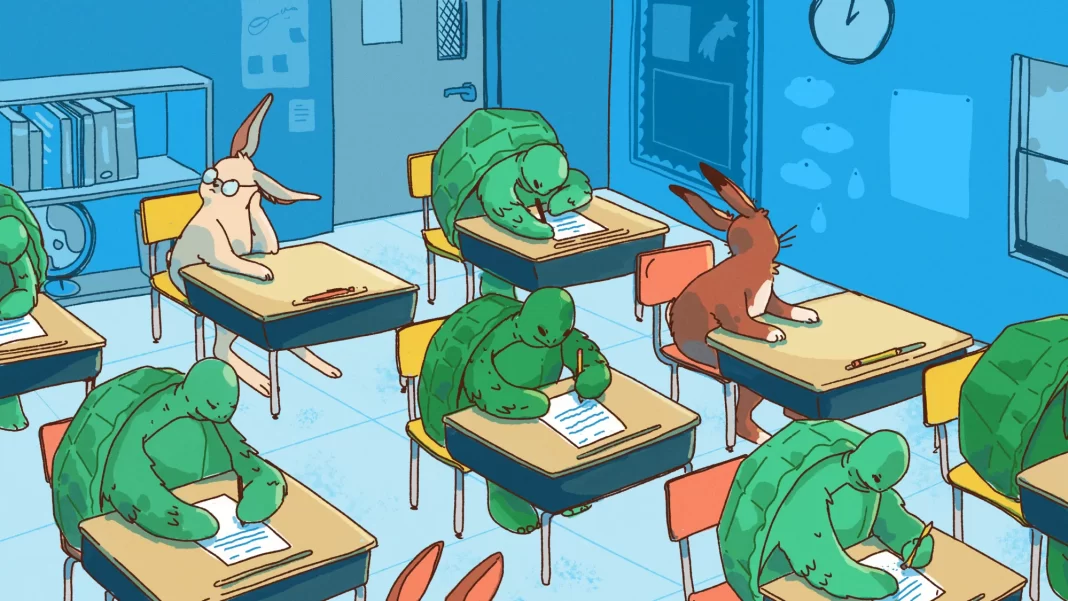Whether you’re in an elementary, middle, or high school setting, you can use these strategies to convert fast finishers into self-directed learners. I highlight low-prep and no-prep activities that extend learning beyond busywork and ensure that your class runs smoother than a greased zip line.
Finish, Check, and Go Further: Introducing Enrichment Activities to Students
When introducing extension activities, clearly communicate the purpose and procedures so your class understands the expectations. Be sure to address why, when, what, and how with the entire class.
- Why: These activities are opportunities to learn more about an academic subject, expand creativity, and enhance critical thinking.
- When: Students can dive into the expansion activities only after you’ve checked their work and given the OK.
- What: What activity options are included? Identify them using a list or bingo board of bonus activities. Identify approved and unapproved websites. Tell them if it’s OK to work on homework from other courses or use their phones. What are the expectations? Clarify acceptable noise levels and reinforce that early finishers should respect peers who are still working. Finally, specify consequences of not following guidelines.
- How: Demonstrate how to retrieve materials quickly and quietly. Provide a simple log sheet where students quickly record the date, the activity chosen, and a brief reflection or rating (e.g., “Loved it,” “Just OK,” “Too easy”). This not only holds them accountable but also helps you spot popular activities so you’ll know exactly which ones to restock and which to retire.
Practical Setup Strategies for Bonus Activities
You can create an inviting enrichment area that supports academic achievement. These easy-to-implement ideas will help students seamlessly transition from “I’m done” to “What’s next?”
- Literary Lounge: Place a couch or beanbag chairs near the class library for students to read a choice book.
- Grab-and-Go “I’m Finished” Strips: Third-grade teacher Tara Dusko created a bulletin board with envelopes containing strips of paper describing each activity for students to pick from. “They glued it to the top of a piece of paper and did the activity,” she explained.
- Brain Buffet Folders: Create activity folders containing lateral thinking puzzles, writing prompts, and logic riddles that demand critical analysis and creative solutions.
- Number Nook: Fill a container with flash cards or a tablet preloaded with math games.
- Digital Discovery Hub: Keep laptops loaded with curated extension activities, and use a Google Doc or learning management system page filled with hyperlinks to series of articles, quizzes, and coding challenges.
- Makeup Work Depot: Place a folder next to the finished-work bin where students can store any incomplete assignments. This setup makes it easy for them to return and complete pending tasks once they’ve wrapped up their current work.
Grade Level–Specific Extension Activities
Many K–12 educators invite early finishers to read a choice novel, organize their backpacks, study for a test, or catch up on homework, as these activities boost academic skills. In this section, I’ll highlight additional options.
Elementary school
These fun, no-fuss activities keep young learners happily engaged as they develop important skills.
- Letter Writing Center: To boost literacy skills, Elizabeth Mulvahill recommends setting up a station with decorative paper or cards for students to write letters to family, friends, or a favorite teacher.
- Comic Strip Activity: Canva provides blank comic strip templates for students to develop narrative and art skills.
- Puzzles: Students can engage in critical thinking as they work through physical or free online jigsaw puzzles. Or provide printouts of free tangram puzzles and sudokus for kids.
- Academic Computer Games: Courtney Schley, reviewing tech games for The New York Times’ “Wirecutter,” recommended Bedtime Math (iOS, Android) for math and Lightbot Jr (iOS, Amazon) and ScratchJr (iOS, Android, Amazon) for coding.
- Canvas Café: Fill this space with sketchbooks, canvases, quality paper, pencils, pipe cleaners (for sculptures), markers, paints, clay, brushes, and pastels. Include materials for mixed media projects and digital drawing tools. To inspire students, keep art challenge cards on hand and include a display of student work.
Middle school
The following activities will help middle school students channel their energy into curiosity-driven projects that they’ll find immersive.
- Magazine Corner: Hook students on independent reading by stocking a rotating magazine rack with timeless favorites like Ranger Rick, celebrated for its animal adventures, and Kazoo, which features short stories spotlighting girl characters and profiles of inspiring women. Add Honest History, a magazine that makes historical events accessible and exciting for young readers, and round out your collection with Brainspace, offering content that spans math, science, art, and more.
- Mindfulness Apps: The nonprofit web- and app-based Smiling Mind supports children’s mental fitness. The popular Headspace audio platform created a dedicated version for children called Headspace for Kids, which includes several mindfulness activities—such as Rest & Relax, Kindness, and Cool Off.
- Comedy Corner: To inspire young comedians, fill a folder with resources and models for writing jokes, such as “How to Write Funny,” LOL 101: A Kid’s Guide to Writing Jokes, and The Don’t Laugh Challenge: 12-Year-Old Edition.
- Journal Paper: “Middle schoolers have big feelings and lots on their mind,” writes Rachael Moshman. “Let them write it out—for their eyes only, unless they want you to read it.” For additional writing inspiration, see my article “50 Writing Prompts for All Grade Levels.”
- Preparation for Globe-Trotter Trivia: Direct students to research unusual facts about a country (e.g., natural wonders, famous figures, ancient sites) and record them on index cards, with the country name on the reverse side. Use the cards in a team quiz game as an active way to cap off the week. To ensure fairness, have learners write their names on the index cards they contributed. When a student’s card is drawn, that student must remain silent and allow teammates to collaborate on an answer.
- Listening Lounge: Jenny M. has a curated list of audiobooks for middle graders, all available on YouTube. And there are many middle-grade public domain audiobooks available for free on Spotify, such as the memoir Narrative of the Life of Frederick Douglass. It will help if you have comfortable seating, headphones, a listening device, and a printed list of links and descriptions for each audiobook ready for easy access.
High school
Because older fast finishers excel with challenge and autonomy, these extension activities invite high school students to independently delve into topics that sharpen advanced critical thinking, enhance creativity, and build real-world skills.
You can also give students the option to propose their own extra work projects (e.g., “May I write my scholarship essay?”). When evaluating this kind of pitch, consider these questions: Does it align with class objectives? Is it designed to be self-directed and quiet? This approach not only validates their creativity but also ensures that every suggestion contributes to a productive and orderly learning environment.
- The Mensa Reading Contest: The Gifted Guru blog recommends a wealth of activities for early finishers; one standout is the Mensa for Kids Excellence in Reading Program. The book list is elite-tier—and those who finish all 116 books win a certificate and a free T-shirt.
- Creative Writing Challenges: The Adroit Journal and Teen Ink offer free-entry contests for short fiction and poetry. Schools can also host themed competitions tied to local issues—such as the impact of urban expansion on marine life or the role of Indigenous traditions in the Pacific Northwest.
- Podcast Production Studio: Students can produce a podcast series connected to class content using a microphone, Audacity (an open-source audio editor), and Anchor.fm (Spotify’s free platform for distributing podcasts). For math classes, students might investigate the role of geometry in famous buildings like the Sydney Opera House or how social media collects and analyzes user data. To minimize disruptions, early finishers can dedicate class time to silent research, planning, and script-writing, while reserving potentially noisy audio recordings for the media center or home.
- Code and Create: Unity Learn provides free tutorials and project-based learning units for students interested in game development. Construct 3 offers an intuitive drag-and-drop interface for creating web-based games.
- Global Language Lab: Set up a language enrichment center with flash cards and audio recordings where students can learn essential foreign phrases such as “Thank you,” “I’m looking for ___,” and “How much is that?” Or encourage learners to practice American Sign Language using Signing Savvy, an online sign language dictionary containing videos of ASL signs and fingerspelled words.
- Researching Future Pathways: Set up a workstation where students can explore postsecondary and career options. Direct students to write a brief reflection on their findings after they access the College Board’s BigFuture College Search tool, the Bureau of Labor Statistics’ Occupational Outlook Handbook for career insights, or Military.com for an overview of the military services.
- SAT Prep: Quizlet offers free SAT practice tests in the form of interactive online flash cards to reinforce key concepts and test-taking strategies.
- Choose Your Inquiry Project: Allow students to research topics from a list of broad topics connected to your curriculum (e.g., contemporary satire, game theory, CRISPR and gene editing). They can showcase their findings through an Ignite-style presentation or craft an I-Search Paper that reflects their research journey and personal insights.
Managing high school extension products requires organizational skills. Keep a dedicated tray, bin, or folder for extra work—I used to call mine The Folder of Awe! Regularly skim collected items and add comments. For ongoing projects, provide labeled physical or digital folders where students can store notes and long-term assignments.
Recognizing and Rewarding Enrichment Activities
Extra credit points can distort the true purpose of assessment by inflating grades beyond actual mastery. This type of arms race leaves students stockpiling points instead of building lasting skills. Instead, spotlight early finishers by regularly holding mini-conferences (“Tell me about that awesome infographic you’re designing!”) or host a monthly “Enrichment Showcase” to celebrate standout projects like student-created podcasts or original poems.
A little recognition goes a long way. Think stickers, shout-outs in the class newsletter, or end-of-year certificates for those who’ve crushed bonus tasks. Quick praise (“You nailed that tricky puzzle!”) reinforces the idea that enrichment work is meaningful, even without a grade attached.
Finally, remember the tortoises among your classroom hares. Occasionally set aside an “Enrichment for Everyone” period to ensure that all students get a chance to join the intellectual party.



